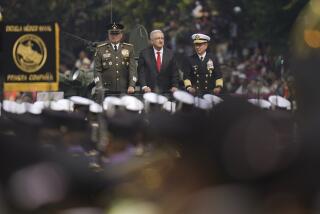Widow of Man Killed by Drug Traffickers Testifies
The widow of an American writer killed by drug traffickers in Mexico in 1985 tearfully described examining her dead husband’s body at the Guadalajara morgue in wrenching testimony Wednesday at the trial of four men charged in the murder of DEA Agent Enrique Camarena.
Mary Evelyn Walker, now a Texas schoolteacher, described in Los Angeles federal court how she was told that the remains of her husband, John Walker, were at the morgue in June, 1985, after she had spent months trying to find him.
She said the State Department called her St. Paul, Minn., home on Feb. 14, 1985, to tell her Walker, a free-lance writer, had disappeared from Guadalajara.
In fact, the writer and his friend, Alberto Radelat, a medical student, were already dead. They had been beaten to death by narcotics traffickers after they apparently stumbled into a party of the Guadalajara drug cartel at the city’s La Langosta restaurant on Jan. 30, 1985, and were mistaken for DEA agents. Their remains were discovered in a local park on June 19, 1985.
Mrs. Walker said she went to the morgue with Radelat’s father. She said she knew one of two bodies lying on tables was that of her husband as soon as she saw it.
“It was only a skeleton, but not just a skeleton,” she testified, trying to contain her tears. “There were parts of his body still on him--one of his eyes, his overlip . . . his mustache. It was John. It was, unmistakably, John.”
Only one of the four men on trial in the Camarena case, Javier Vasquez Velasco, is accused of the Walker and Radelat murders, which occurred only eight days before the abduction and slaying of the agent in Guadalajara.
Vasquez is being tried with the other three defendants, over the objections of his defense lawyer, because U.S. District Judge Edward Rafeedie determined that there were significant connections between the killings.
At the start of the trial, federal prosecutor John Carlton said Guadalajara narcotics traffickers committed a series of retaliatory acts against the DEA because they were angry about major raids in 1984 that had cost the traffickers $5 billion.
The murders of Walker and Radelat were described as being among those retaliatory acts.
Another of those acts, according to prosecutors, was an attempt by drug traffickers to kill a Guadalajara attorney, Cesar Garcia Bueno, after they learned he was providing information to Camarena.
Testifying Wednesday from a wheelchair, Garcia described how a gunman entered a Guadalajara restaurant, shot him in the back, and said, “you’re dying, because you are a snitch.”
Later in the day, the prosecution ran into some difficulties.
In one potentially significant development, Thomas Gomez, a DEA agent who was sent to Guadalajara on special assignment in the fall of 1984, said that he had been in the Mexican city from mid-October to mid-November of that year and had not seen Juan Ramon Matta Ballesteros, one of the men he was assigned to check out.
Matta is one of the four defendants in the case. The government has accused Matta, a convicted Honduran drug lord, of being one of the plotters of Camarena’s kidnaping and murder and allege that he took part in meetings to plan the assassination in October, 1984, in Guadalajara.
Outside court, Matta’s defense lawyer, Martin R. Stolar, said he thought Gomez’s statement was “very significant” because it raised questions about the government’s charges against Matta.
At mid-afternoon, another key government witness, Enrique Placentia Aguilar, a former member of the Guadalajara police SWAT team, said he was present at a December, 1984, meeting during which Camarena’s photo was passed around among a number of drug traffickers--including Ernesto Fonseca Carrillo, Rafael Caro Quintero and others linked to the Camarena killing.
Placentia said that defendant Vasquez was among those who were at the meeting. However, he was unable to identify him in court Wednesday.
Later, outside the presence of the jury, Assistant U.S. Atty. Manuel Medrano, one of the prosecutors, said that Placentia had identified Vasquez recently when he was shown a photocopy of his photo.
Placentia’s forgetfulness was potentially harmful to the prosecution. He allegedly was an eyewitness to the Walker killing at the restaurant and was to have testified that Vasquez was present.
The final witness of the day was Hector Cervantes Santos, another former Mexican law enforcement officer, who served for several years as a bodyguard to a Mexican attorney, Javier Barba Hernandez, who was closely allied with drug traffickers. Barba was killed in a 1986 shoot-out with Mexican police, amid rumors that high government officials were concerned that he might be questioned about the Camarena killing.
According to the prosecution’s case, some of the key meetings to plan Camarena’s abduction and killing were held at Barba’s house in late 1984. Late Wednesday, Cervantes, now a paid U.S. government informant, said he was present at a September, 1984, baptism for Barba’s son.
Cervantes said that defendant Ruben Zuno Arce was also present at the baptism, along with several major drug traffickers; Javier Garcia Paniagua, now the Mexico City police chief and formerly the head of Mexico’s leading political party, the PRI, and defendant Vasquez.
More to Read
Sign up for Essential California
The most important California stories and recommendations in your inbox every morning.
You may occasionally receive promotional content from the Los Angeles Times.










